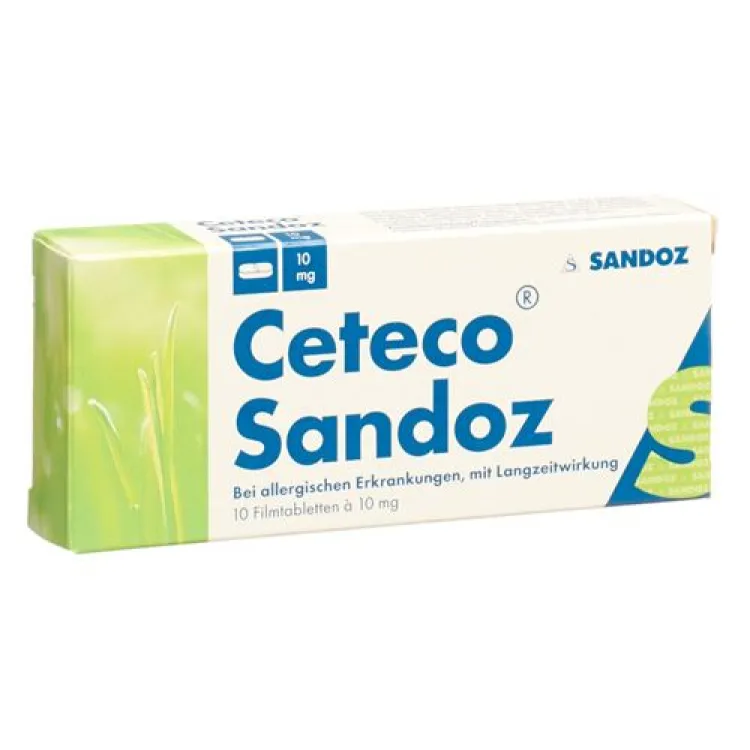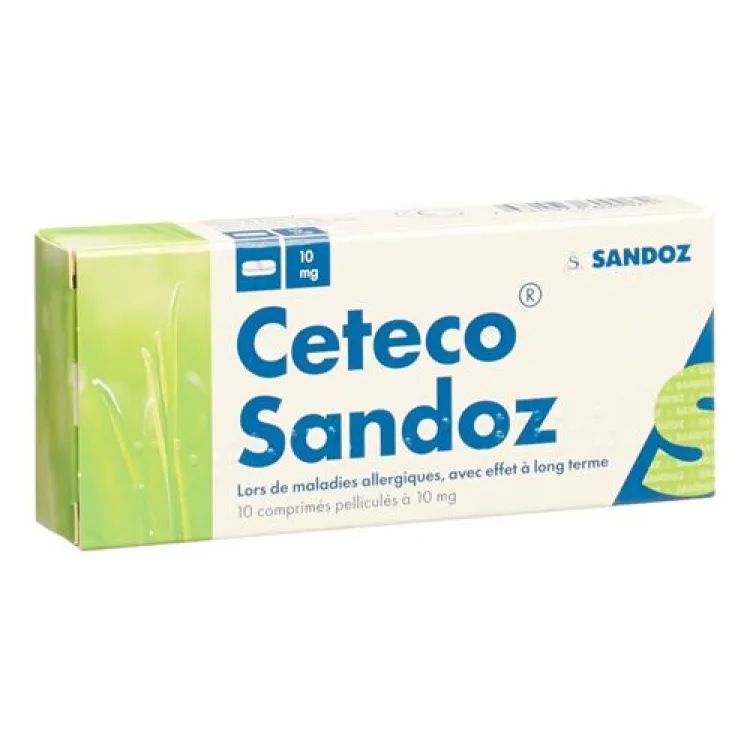Ceteco Sandoz film-coated tablets 10 mg 10 pcs
Ceteco Sandoz Filmtablet 10 mg 10 pcs
-
20.37 USD

- Availability: In stock
- Distributor: SANDOZ PHARMACEUTICALS AG
- Brand: Ceteco
- Product Code: 4962983
- ATC-code R06AE07
- EAN 7680573600062
Ingredients:
Description
What Ceteco Sandoz is and what it is used for
Ceteco Sandoz is effective in the basic treatment of allergic diseases. It blocks the action of histamine, which is released in the body during allergic reactions. Ceteco Sandoz is used in adults and children from 6 years of age to treat allergic diseases such as hay fever, allergic rhinitis and allergic conjunctivitis and chronic hives (which are often associated with itching). The treatment duration for children with allergic rhinitis must not exceed 4 weeks. Ceteco Sandoz is available in the form of film-coated tablets or drops.
When should Ceteco Sandoz not be taken?
Patients who are hypersensitive to the active substance, other related substances or any other component of Ceteco Sandoz should not use the preparation.
Women who are breastfeeding should not use Ceteco Sandoz. Pregnant women should only take Ceteco Sandoz if prescribed by a doctor.
Since Ceteco Sandoz film-coated tablets contain lactose, patients with rare hereditary disorders such as galactose intolerance, the Lapp lactase deficiency or glucose-galactose malabsorption syndrome should not take the film-coated tablets.
Patients with end-stage kidney disease (with a glomerular filtration rate (GFR) below 15 ml/min) should not take Ceteco Sandoz.
When is caution required when taking Ceteco Sandoz?
Children under 6 years of age should not be treated with Ceteco Sandoz. You should only take Ceteco Sandoz film-coated tablets and theophylline (an active substance used to treat shortness of breath) after consulting your doctor. Ceteco Sandoz and preparations containing glipizide (a drug used to treat diabetes) should not be taken together. It is recommended to take the Glipizide medication in the morning and Ceteco Sandoz in the evening.
Ceteco Sandoz should be used with caution in epileptics as it could potentially trigger seizures.
Caution should be exercised when using Ceteco Sandoz at the same time as sedatives or painkillers.
Caution should be exercised when driving a motor vehicle or using machines as taking Ceteco Sandoz may make you drowsy.
It is advisable not to drink alcohol during treatment with Ceteco Sandoz.
If you are going to have an allergy test, ask your doctor if you should stop taking Ceteco Sandoz for a few days before the test, as this medicine could affect the result of an allergy test.
Ceteco Sandoz can increase the risk of urinary retention in patients with a tendency to urinary retention (such as spinal cord injury, prostate enlargement).
Tell your doctor, pharmacist or druggist if you
- suffer from other diseases
- have allergies or
- are taking other medicines (including those you bought yourself!).
Can Ceteco Sandoz be taken during pregnancy or while breastfeeding?
No undesirable effects have been found in animal experiments. However, like other medicines, Ceteco Sandoz should not be taken during pregnancy. If you accidentally take Ceteco Sandoz during pregnancy, no harmful effects on the unborn child are to be expected, but the treatment should be stopped immediately. Talk to your doctor if you are pregnant or planning to become pregnant. Ceteco Sandoz should not be taken during breast-feeding as the active ingredient passes into breast milk.
How do you use Ceteco Sandoz?
For adults and children over 6 years: The usual dose is one Ceteco Sandoz film-coated tablet once a day. For children from 6 to 12 years of age, the dosage can be divided into two intakes (half a film-coated tablet in the morning and half in the evening). If slight side effects (tiredness, headaches, gastrointestinal disorders) occur that do not resolve on their own, it is also advisable for adults to take half a film-coated tablet in the morning and half in the evening.
Patients with moderate to severe renal impairment
Patients with impaired kidney function (kidney failure) may receive a lower dose, which depends on the severity of the kidney disease and is determined by the doctor treating you. The Ceteco Sandoz film-coated tablets should be swallowed whole with a glass of liquid.
Ceteco Sandoz can be taken with or without food. The duration of treatment depends on the type, duration and course of the symptoms and is determined by the doctor. If you forget to take a dose of Ceteco Sandoz, simply continue the treatment. Please do not take a double dose to make up for a missed dose. In the event of an overdose, you should contact your doctor immediately.
Follow the dosage given in the package leaflet or prescribed by your doctor. If you think the medicine is too weak or too strong, talk to your doctor, pharmacist or druggist.
What side effects can Ceteco Sandoz have?
The following side effects can occur when taking Ceteco Sandoz:
Common (affects 1 to 10 users in 100)
Mild tiredness, mild headache, drowsiness, dizziness, dry mouth, nausea have been reported.
Uncommon (affects 1 to 10 users in 1000)
Gastrointestinal disorders (e.g. diarrhea, abdominal pain), feeling unwell, itching, rash, agitation, abnormal sensations on the skin, runny nose, sore throat, feeling weak.
Rare (affects 1 to 10 users in 10,000)
Hypersensitivity reactions, seizures, circulatory failure, liver damage, urticaria (nettle rash), tachycardia, edema (swelling), weight gain, confusion, hallucinations, insomnia, aggression, extreme tiredness, depression.
Very rare (affects less than 1 in 10,000 people)
Movement disorders, tremors, nervous twitches (tics), photosensitivity reactions, allergic shock, urination disorders (abnormal urination), visual disturbances and uncontrollable circling movements of the eyes, thrombocytopenia (low blood platelet count), dysgeusia (altered sense of taste), syncope (fainting).
Frequency not known (cannot be estimated from the available data)
Loss of memory (amnesia), memory problems, difficulty concentrating, dizziness (sensation of spinning or moving), urinary retention, increased appetite, suicidal thoughts, nightmares, joint pain, muscle pain, acute skin rash over the whole body with pustules and liver inflammation, vasculitis, hearing loss.
Pruritus and/or urticaria have been reported following discontinuation of cetirizine.
If you experience any of these side effects, stop taking Ceteco Sandoz and tell your doctor.
If you notice side effects, contact your doctor, pharmacist or druggist. This also applies in particular to side effects that are not listed in this leaflet.
What should also be noted?
Durability
The medicinal product may only be used up to the date marked “EXP” on the package.
Storage Notice
Store in the original packaging, at room temperature (15-25°C) and out of the reach of children.
More information
Your doctor, pharmacist or druggist can provide you with further information. These people have the detailed information for specialists.
What does Ceteco Sandoz contain?
1 film- coated tablet (divisible) contains 10 mg cetirizine dihydrochloride as an active ingredient and excipients.
Registration Number
57360 (Swissmedic)
Where can you get Ceteco Sandoz? What packs are available?
You can get Ceteco Sandoz in packs of 10 film-coated tablets in pharmacies and drugstores without a doctor's prescription.
Marketing Authorization Holder
Sandoz Pharmaceuticals AG, Risch; Domicile: Red Cross





